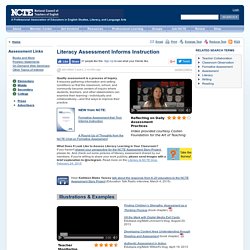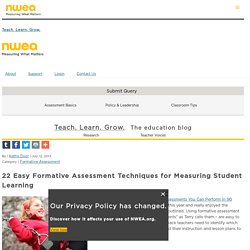

Library Girl's Picks: The Best Digital Tools for Formative Assessment. On Monday, I had the opportunity to participate in another fab edition of the TL Virtual Cafe webinar series.

This month's PD offering was an "Edutech Smackdown" featuring the Queen of All Things Library: Joyce Valenza. I love these smackdown sessions because they are the ultimate crowdsourced PD. Everybody grabs a slide (or two or ten) and when their time comes, takes the mic to share something they love. They are fun, fast paced and the cream always seems to rise to the top. Delish! That said, for my few minutes with the mic, I decided to focus my attention on formative assessment. Which brings me back to formative assessment. When incorporated into a lesson, formative assessment provides the teacher librarian with a snapshot of the teaching and learning while it is still happening.
Obviously, this is not rocket science. Formative Assessment Infographic. Formative Assessment. Reflecting on reflection. This is hardly wasting time.

It is this kind of sitting that allows the mind to wander, to wonder and to speculate. Sven Birkert calls this process "resonance" in The Gutenberg Elegies: Resonance—there is no wisdom without it. Resonance is a natural phenomenon, the shadow of import alongside the body of fact, and it cannot flourish except in deep time. Incubation We are looking for something. Making our way toward inspiration and illumination - the "Aha! " This incubation process usually thrives on reverie and musing - mood states within which the subconscious works its best magic.
Reverie Reverie is the dream state during which incubation, percolation and fermentation may take place. Daydream, daydreaming, trance, musing; inattention, inattentiveness, woolgathering, preoccupation, absorption, abstraction, lack of concentration Reflecting on a Painting, a Poem, a Photograph or an Essay Here are some examples that require such thought: What will it mean to be "well read" in the next decade?
Literacy Assessment Informs Instruction. Quality assessment is a process of inquiry.

It requires gathering information and setting conditions so that the classroom, school, and community become centers of inquiry where students, teachers, and other stakeholders can examine their learning—individually and collaboratively—and find ways to improve their practice. NEW from NCTE: Formative Assessment that Truly Informs Instruction A Round-Up of Thoughts from the NCTE Chat on Formative Assessment What Does It Look Like to Assess Literacy Learning in Your Classroom? If you haven't shared your perspective for the NCTE Assessment Story Project, please do. Hear Kathleen Blake Yancey talk about the response from K-20 educators to the NCTE Assessment Story Project (Education Talk Radio interview, March 4, 2015) Finding Children’s Strengths: Assessment as a Thinking Process (book chapter) Hit the Mark with Digital Media Exit Cards,Edutopia.org/Matt Levinson's blog, August 20, 2013 Daily Assessment with Tiered Exit Cards, Teaching Channel.
Why Check for Understanding? 22 Easy Formative Assessment Techniques for Measuring Student Learning. I came across Terry Heick’s blog – 10 Assessments You Can Perform In 90 Seconds – at TeachThought from earlier this year and really enjoyed the formative assessment strategies that he outlined.

Using formative assessment techniques in class – or “simple assessments” as Terry calls them – are easy to administer and provide the instant feedback teachers need to identify which students need more help, and then adjust their instruction and lesson plans to help them. Visit Terry’s blog above to get more detail on the following ten formative assessment techniques: 1.
New Clothes 2. Do’s and Don’ts 3. Combining Terry’s ten with the ten we’ve blogged about can give teachers 20 great formative assessment strategies for measuring student learning. 11. Here are a couple more assessments you can use to elicit evidence of student learning. 21. 22. Formative and Summative Assessments in the Classroom. Printable article Successful middle schools engage students in all aspects of their learning.

There are many strategies for accomplishing this. One such strategy is student-led conferences. As a classroom teacher or administrator, how do you ensure that the information shared in a student-led conference provides a balanced picture of the student's strengths and weaknesses? The answer to this is to balance both summative and formative classroom assessment practices and information gathering about student learning. Assessment is a huge topic that encompasses everything from statewide accountability tests to district benchmark or interim tests to everyday classroom tests.